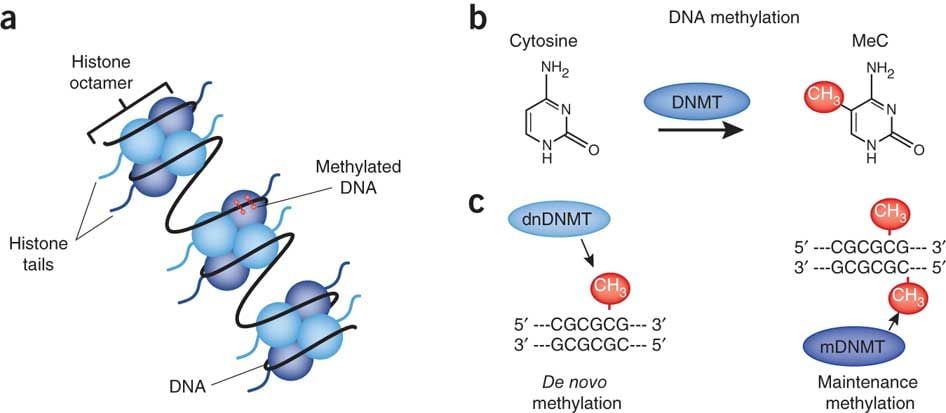Interesting Science Videos
DNA Methylation Definition
DNA methylation is a process by which methyl groups are added to the DNA molecule.
- It is an epigenetic mechanism that occurs by the addition of a methyl (-CH3) group to DNA, thereby often modifying the function of the genes and affecting gene expression.
- The most widely characterized DNA methylation process is the covalent addition of the methyl group at the 5-carbon of the cytosine ring resulting in 5-methylcytosine (5-mC), also informally known as the “fifth base” of DNA.
- These methyl groups project into the major groove of DNA and inhibit transcription.
- In human DNA, 5-methylcytosine is found in approximately 1.5% of genomic DNA.
- It is typically removed during zygote formation and then re-established in the embryo at approximately the time of implantation.
- It is the basis of chromatin structure and usually is found in a CpG dinucleotide context.
- Research has shown that methylation plays a crucial role in the regulation of gene expression and that these modifications tend to occur at specific locations within the genomes of different species.
- It has been demonstrated as a vital contributor to a wide range of cellular processes, and aberrant methylation patterns have been linked to several human diseases.
- Historically, it was discovered in mammals as early as DNA was identified as the genetic material.
- In 1948, Rollin Hotchkiss first discovered modified cytosine in the preparation of calf thymus using paper chromatography.
- It was hypothesized that this fraction was 5-methylcytosine (5mC) because it separated from cytosine in a manner that was similar to the way that thymine (also known as methyluracil) separated from uracil, and he further suggested that this modified cytosine existed naturally in DNA.
- Although many researchers proposed that it might regulate gene expression, it was not until the 1980s that several studies demonstrated that it was involved in gene regulation and cell differentiation.
- It is now well recognized that, in concert with other regulators, it is a major epigenetic factor influencing gene activities.

Image Source: Nature Neuroscience
Principle
- Although virtually all cells in an organism contain the same genetic information, not all genes are expressed simultaneously by all cell types.
- In a broader sense, epigenetic mechanisms mediate the diversified gene expression profiles in a variety of cells and tissues in multicellular organisms.
- Once such a major epigenetic mechanism that involves direct chemical modification to the DNA is called DNA methylation.
- During development, the pattern of DNA methylation in the genome changes as a result of a dynamic process involving both de novo DNA methylation and demethylation.
- As a consequence, differentiated cells develop a stable and unique DNA methylation pattern that regulates tissue-specific gene transcription.
Significance
- Most DNA methylation is essential for normal development.
- It plays a very important role in a number of key processes including genomic imprinting, X-chromosome inactivation, and suppression of repetitive element transcription and transposition and, when dysregulated, contributes to diseases like cancer.
- DNA methylation in different genomic regions may exert different influences on gene activities based on the underlying genetic sequence.
Control
- The addition of methyl groups is controlled at several different levels in cells and is carried out by a family of enzymes called DNA methyltransferases (DNMTs).
- Three DNMTs (DNMT1, DNMT3a, and DNMT3b) are required for the establishment and maintenance of DNA methylation patterns.
- Two additional enzymes (DNMT2 and DNMT3L) may also have more specialized but related functions.
References
- https://www.whatisepigenetics.com/dna-methylation/
- https://www.nature.com/scitable/topicpage/the-role-of-methylation-in-gene-expression-1070/
- https://www.ncbi.nlm.nih.gov/pmc/articles/PMC3521964/
- https://www.ncbi.nlm.nih.gov/pmc/articles/PMC3174260/
- https://epigenie.com/key-epigenetic-players/important-dna-methylation-factors/
